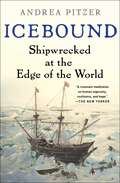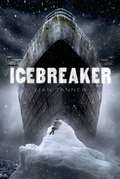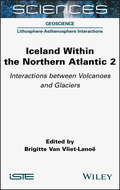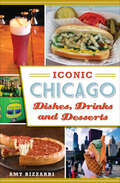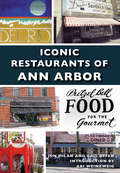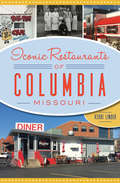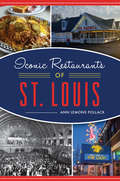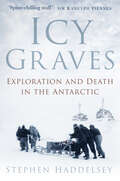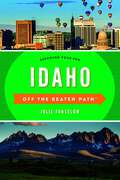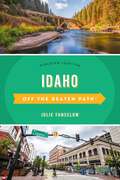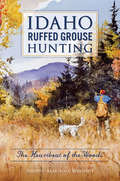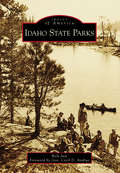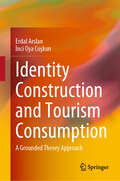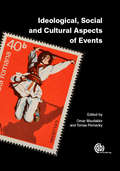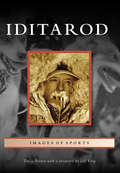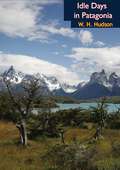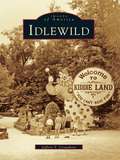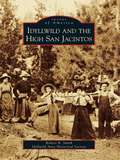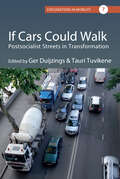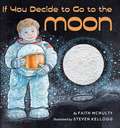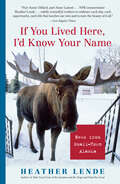- Table View
- List View
Icebound: Shipwrecked at the Edge of the World
by Andrea PitzerIn the bestselling tradition of Hampton Sides&’s In the Kingdom of Ice, a &“gripping adventure tale&” (The Boston Globe) recounting Dutch polar explorer William Barents&’ three harrowing Arctic expeditions—the last of which resulted in a relentlessly challenging year-long fight for survival.The human story has always been one of perseverance—often against remarkable odds. The most astonishing survival tale of all might be that of 16th-century Dutch explorer William Barents and his crew of sixteen, who ventured farther north than any Europeans before and, on their third polar exploration, lost their ship off the frozen coast of Nova Zembla to unforgiving ice. The men would spend the next year fighting off ravenous polar bears, gnawing hunger, and endless winter. In Icebound, Andrea Pitzer masterfully combines a gripping tale of survival with a sweeping history of the great Age of Exploration—a time of hope, adventure, and seemingly unlimited geographic frontiers. At the story&’s center is William Barents, one of the 16th century&’s greatest navigators whose larger-than-life ambitions and obsessive quest to chart a path through the deepest, most remote regions of the Arctic ended in both tragedy and glory. Journalist Pitzer did extensive research, learning how to use four-hundred-year-old navigation equipment, setting out on three Arctic expeditions to retrace Barents&’s steps, and visiting replicas of Barents&’s ship and cabin. &“A resonant meditation on human ingenuity, resilience, and hope&” (The New Yorker), Pitzer&’s reenactment of Barents&’s ill-fated journey shows us how the human body can function at twenty degrees below, the history of mutiny, the art of celestial navigation, and the intricacies of building shelters. But above all, it gives us a firsthand glimpse into the true nature of courage.
Icebreaker (The Icebreaker Trilogy #1)
by Lian Tanner<p>An enthralling adventure set in a strange world on the high seas. <p>Petrel is an outcast on the ancient ship, an icebreaker, that has been following the same course for 300 years. In that time, the ship's crew has forgotten its original purpose and broken into three warring tribes. Everyone has a tribe except Petrol. Nicknamed the Nothing Girl, Petrel has been ostracized ever since her parents were thrown overboard as punishment for a terrible crime. <p>But Petrel is a survivor. She lives in the ship's darkest corners, and trusts no one except two large gray rats - that is, until a mysterious boy is discovered barely alive on an iceberg, and brought onto the ship. He claims to have forgotten even his name. The tribes don't trust strangers, so Petrel hides the boy, hoping he will be her friend. What she doesn't know is that the ship guards a secret - a secret the boy has been sent to destroy.</p>
Iceland Within the Northern Atlantic, Volume 2: Interactions between Volcanoes and Glaciers
by Brigitte Van Vliet-LanoëThe volcanic island of Iceland is a unique geological place due both to its position in the middle of the Atlantic Ocean and its repeated glaciations. It has been an accurate recorder of geodynamic and regional climatic evolutions for at least the last 15 million years.This book studies the Quaternary magmatism associated with the deep Iceland hotspot and, in particular, its distinctive geochemical and volcanological characteristics. It also analyzes that Arctic glacierization as it relates to the opening of the North Atlantic and the appearance of today’s ocean currents. We will also investigate the Quaternary glaciation as it affected Iceland in its oceanic context, particularly on the basis of radiometric dating, looking at the formation of the Greenland and Scandinavian ice sheets and data from marine sediment. Finally, it explores the specific environmental features of the island, from the end of the last ice age to global warming today.This book brings together the internal and external geodynamics of our planet to understand how Iceland functions and its role as a recorder of the paleoclimatic evolution of the Northern Hemisphere.
Iconic Chicago Dishes, Drinks and Desserts (American Palate Ser.)
by Amy BizzarriA celebration of Chicago food that goes far beyond deep-dish pizza—filled with recipes, photos, and local history! The food that fuels hardworking Chicagoans includes such local classics as Spinning Salad, Flaming Saganaki, Jumpballs, Jim Shoes, Pizza Puffs, and Pullman Bread. The restaurants, bakeries, taverns, and pushcarts of the city, cherished from one generation to the next, offer satisfying warmth in winter and sweet refreshment in summer. From the city that created the Cape Cod Room&’s Bookbinder Soup and the Original Rainbow Cone, as well as Andersonville Coffee Cake and Taylor Street&’s Italian Lemonade, this combination of cookbook and culinary history is a treat for Chicagoans, visitors, and anyone who loves hearty Midwestern fare.
Iconic Restaurants of Ann Arbor (Images Of America Ser.)
by Jon Milan Gail Offen Ari WeinzweigWhat is an iconic Ann Arbor restaurant? Ask anyone who has ever spent time there as a student, traveler, or “townie,” and they are likely to name several favorites in an instant. From debating the best place to celebrate or console on football Saturdays to deciding where to eat after the bars close, the choices have always sparked passionate conversation. In Ann Arbor, people are known to have strong feelings about the best places for pizza, coffee, beer, burgers, noodles, and burritos. Although many of the go-to hangouts are long gone, a surprising number still thrive. And there are always a few newcomers coming along to win the hearts of the next generation of diners, nibblers, and noshers. Some are fine restaurants and taverns, and others are lunch counters, diners, carry-outs, and drive-ins—but in each and every case, they are unique and together make up a collection of iconic local eateries.
Iconic Restaurants of Columbia, Missouri (American Palate)
by Kerri LinderColumbia's culinary history is chock-full of restaurants that not only satisfied appetites but also provided gathering places to build community. Gentry's Tavern served wild game along the Boonslick Trail. Hungry and broke students could grab a meal on credit from Ralph Morris at the Ever Eat Café during the Depression. During and after World War II, Ambrose's Café required students to give up their seats to men in uniform. Segregation didn't stop Annie Fisher from making her fortune serving her famous beaten biscuits. These stories and more are as rich as the cinnamon rolls served at Breischs. Join Columbia native Kerri Linder as she shares the stories and memories wrapped around the food of Columbia's iconic restaurants.
Iconic Restaurants of St. Louis (American Palate)
by Ann Lemons PollackSt. Louis has an appetite for sure. The places that made it that way have fascinating tales of hard work and good flavor. From the white tablecloths of Tony's to the counter at Woofie's, the Gateway City came to culinary prominence. The glories of Union Station's Fred Harvey restaurant and simple spots like the Piccadilly highlight the variety. Mai Lee serves as the city's first Vietnamese restaurant, and Mammer Jammer was home of St. Louis's hottest sandwich. Recipes are included, like a favorite soup of Missouri's own Harry Truman. Ann Lemons Pollack, author of Lost Restaurants of St. Louis, found these stories and more, all to whet your appetite.
Icy Graves: Exploration and Death in the Antarctic
by Stephen HaddelseyEver since Captain Cook sailed into the Great Southern Ocean in 1773, mankind has sought to push back the boundaries of Antarctic exploration. The first expeditions tried simply to chart Antarctica’s coastline, but then the Sixth International Geographical Congress of 1895 posed a greater challenge: the conquest of the continent itself. Many would die in the attempt. Icy Graves uses the tragic tales not only of famous explorers like Robert Falcon Scott and Aeneas Mackintosh, but also of many lesser-known figures, both British and international, to plot the forward progress of Antarctic exploration. It tells, often in their own words, the compelling stories of the brave men and women who have fallen in what Sir Ernest Shackleton called the ‘White Warfare of the South’.
Idaho Off the Beaten Path®: Discover Your Fun (Off the Beaten Path Series)
by Julie FanselowWhether you&’re a visitor or a local looking for something different, Idaho Off the Beaten Path shows you the Gem State with new perspectives on timeless destinations and introduces you to those you never knew existed––from the best in local dining to quirky cultural tidbits to hidden attractions, unique finds, and unusual locales. So if you&’ve &“been there, done that&” one too many times, get off the main road and venture Off the Beaten Path.
Idaho Off the Beaten Path®: Discover Your Fun (Off the Beaten Path Series)
by Julie FanselowWhether you&’re a visitor or a local looking for something different, Idaho Off the Beaten Path shows you the Gem State with new perspectives on timeless destinations and introduces you to those you never knew existed––from the best in local dining to quirky cultural tidbits to hidden attractions, unique finds, and unusual locales. So if you&’ve &“been there, done that&” one too many times, get off the main road and venture Off the Beaten Path.
Idaho Ruffed Grouse Hunting: The Heartbeat of the Woods (Sports)
by Andrew Marshall WaymentRuffed grouse hunting is to bird hunting what fly fishing is to fishing--the pinnacle of the sport. Grouse hunters are a diehard lot consumed by chasing evasive birds through impenetrable thickets. Back east, grouse hunting has a rich, long-standing literary history, with great authors such as Burton Spiller, William Harnden Foster, Grampa Grouse and many others. Tapping into and carrying on this literary tradition, hunter and author Andrew Wayment offers stories from years of grouse hunting throughout the Gem State. Grouse hunters everywhere will relate to and enjoy this intimate look into "ruffin' it in Idaho."
Idaho State Parks (Images of America)
by Foreword By Andrus Rick JustIdaho’s state parks have been called the “jewels” of the Gem State. The story of how those jewels came to be involves political intrigue, much resistance, some philanthropy, and a touch of irony. Sen. Weldon B. Heyburn famously said that state parks were “always a political embarrassment.” Idaho’s first state park was named after him. Today, Idaho’s 30 state parks host five million people a year. Visitors come to boat, camp, bike, climb, hike, fish, and make memories in the great outdoors. This book tells the story of Idaho’s diverse state parks—from Priest Lake in Idaho’s panhandle to Bear Lake in the southeast corner of the state—through a wealth of historical photographs. A variety of parks are featured, including ones that were lost, found, or never came to fruition.
Identity Construction and Tourism Consumption: A Grounded Theory Approach
by İnci Oya Coşkun Erdal ArslanThis book explores how identity plays a pivotal role in tourism consumption. Almost all tourism-related consumption studies underestimate or refer inadequately to identity's relationship with tourism consumption. As identity phenomenon is considerably a new subject in the tourism literature, this book examines its relationship with the consumption theory. It is of interest to readers curious about how pre-, during, and post-consumption activities affect a person's identity and vice versa. This book contains an analysis of consumption theories and a summary of literature identifying the phenomenon's evolution through pre-modern, modern, and post-modern periods. In this context, this book aims to enlighten the interactions between identity construction and tourism consumption. The grounded theory, one of the qualitative research approaches, was applied to accomplish the relevant purpose, and in-depth interviews were recruited following the method approach stages to enable the researchers to gain new insights into the subject. By presenting the identity tended tourism consumption model, this book provides a set of profound contributions to the relevant literature and insight for practitioners/decision-makers and entrepreneurs. This book attempts to clarify the tourists' consumption process and understand how the interactions between identity construction and tourism consumption work. The qualitative methodology (grounded theory) allows in-depth analysis and insights of the participants of the study on their definitions of themselves as human beings and as tourists, decisions on their travel plans, their considerations, motivations to travel and destination preferences, interactions with others, vacation activities, evaluations on their travel experiences, et cetera. Therefore, this book appeals to readers of marketing, business operations, sociology, and economics.
Identity and Heritage
by Douglas C. Comer Christopher Prescott Peter F. Biehl Hilary A. SoderlandThis book will suggest new agendas for identity and heritage studies by means of presenting contentious issues facing archaeology and heritage management in a globalized world. The book is not only present the variability of heritage objectives and experiences in the New and Old World, and opens a discussion, in a shrinking world, to look beyond national and regional contexts. If the heritage sector and archaeology are to remain relevant in our contemporary world and the near future, there are a number of questions concerning the politics, practices and narratives related to heritage and identity that must be addressed. Questions of relevance in an affluent, cosmopolitan setting are at odds with those relevant for a region emerging from civil war or ethnic strife, or a national minority battling oppression or ethnic cleansing. A premise is that heritage represents a broad scope of empirically and theoretically sound interpretations - that heritage is a response to contemporary forces, as much as data. It is therefore necessary constantly to evaluate what is scientifically accurate as well as what is valid and relevant and what can have a contemporary impact.
Identity and Intercultural Exchange in Travel and Tourism
by Anthony David BarkerThis book looks at the relationship between questions of identity formation and modern practices in travelling and tourism. Unprecedented levels of mobility and international exchange over the last 100 years have raised questions about the stability of national and personal identities and new and creative patterns of behaviour and self-realisation are now emerging due to the enormous commercial interests that lie behind the modern travel and tourism industries. The volume will consider these issues and the challenges they create in various geographical contexts (Germany, Spain, Romania, Italy, Africa) and concludes with a number of case studies from the Portuguese context, where the revenues from tourism are integral to its economy and a lifeline in the current economic crisis.
Identity at Work
by Eric OlmedoThis book investigates the interface of ethnicity with occupation, empirically observed in luxury international hotels in Kuala Lumpur, Malaysia. It employs the two main disciplines of anthropology and sociology in order to understand the root causes and meaning of ethnicity at work within the hospitality industry sector. More specifically, it observes social change in a multi-ethnic and non-secular society through an ethnographic study located in a micro organisation: the Grand Hotel. At the individual level, this research shows how identity shifts and transformation can be mediated through the consumption and manipulation of food at the workplace. In addition, it combines an ambitious theoretical discussion on the concept of ethnicity together with empirical data that highlights how ethnicity is lived on an everyday basis at a workplace manifesting the dynamics of cultural, religious and ethnic diversity. The book presents the quantitative and qualitative findings of two complementary surveys and pursues an interdisciplinary approach, as it integrates methodologies from the sociology of organisations with classic fieldwork methods borrowed from ethnology, while combining French and Anglo-Saxon schools of thoughts on questions of identity and ethnicity. The results of the cultural contact occurring in a westernised pocket of the global labour market - in which social practices derive from the headquarters located in a society where ethnicity is self-ascribed - with Malaysian social actors to whom ethnicity is assigned will be of particular interest for social scientists and general readers alike.
Ideological, Social and Cultural Aspects of Events
by Omar MoufakkirThere is an ever growing importance of events in modern society and until now existing literature on events has been dominated by the economic perspective. Social and Cultural Aspects of Events addresses the social and cultural side of events and explores the role they have in fostering change and community development. It examines the transformatory function of events in the context of development studies - as phenomena that can promote and facilitate human development, including social, societal and individual change. This book provides vital and timely exploration and encourages the study of more diverse themes within event management.
Iditarod (Images of Sports)
by Tricia Brown Jeff KingFor sled dog-racing fans worldwide, the most important calendar day is the first Saturday in March, when teams convene for the start of mushing's Superbowl--the Iditarod Trail Sled Dog Race®. Every year, as it has since 1973, this ultimate challenge begins in the state's most populated city, Anchorage, and then dives into the Alaska Bush on a historic trail that wends over mountain ranges, along frozen rivers, and onto the Bering Sea ice. The finish line lies 1,000-plus miles away in Nome, beneath a giant, burled archway. There, dogs and their drivers are greeted by masses of locals, vacationing fans, officials, media, and other mushers who intimately know what that team has just endured. To simply finish is the goal for entrants; to win is the accomplishment of a rare few. Indeed, more people have climbed Mount Everest than have finished the Iditarod®.
Idle Days in Patagonia
by W. H. Hudson"Idle Days in Patagonia" by W. H. Hudson is a captivating travel memoir that transports readers to the wild and remote landscapes of Patagonia. Hudson, a renowned naturalist and author, offers an intimate and vivid portrayal of his explorations in this untamed region at the southern tip of South America.Written with the keen eye of a naturalist and the eloquence of a seasoned storyteller, Hudson's narrative captures the essence of Patagonia's rugged beauty and its rich biodiversity. He shares his observations of the diverse wildlife, from majestic condors soaring overhead to the enigmatic guanacos grazing on the open plains. Through detailed descriptions and personal anecdotes, Hudson brings to life the unique flora and fauna that inhabit this vast and sparsely populated land.Hudson's journey is not only a scientific expedition but also a philosophical exploration. He reflects on the simplicity and solitude of life in Patagonia, finding solace and inspiration in its untouched nature. His encounters with the indigenous people and their harmonious relationship with the environment offer profound insights into the cultural heritage of the region."Idle Days in Patagonia" is more than a travelogue; it is a meditation on the natural world and humanity's place within it. Hudson's lyrical prose and profound appreciation for nature invite readers to slow down and immerse themselves in the timeless beauty of Patagonia. His reflections on the passage of time, the cycles of nature, and the fleeting moments of tranquility resonate deeply, making this work a timeless classic.This book is an essential read for nature enthusiasts, travelers, and anyone seeking to escape the hustle and bustle of modern life. W. H. Hudson's "Idle Days in Patagonia" offers a serene and contemplative journey through one of the world's last great wildernesses, leaving readers with a lasting impression of Patagonia's enchanting landscapes and the author's profound connection to nature.
Idlewild (Images of America)
by Jeffrey S. CroushoreLocated in the scenic Laurel Highlands of western Pennsylvania, America's third oldest amusement park, Idlewild, was founded in 1878 as a picnic ground along the Ligonier Valley Rail Road. Its tranquil setting quickly established Idlewild as the premier place for church, school, and corporate picnics, as well as a recreational getaway for families. Idlewild added new amusements and facilities as its crowds continued to grow, but it always strove to maintain the picturesque landscape of the site. Soon a full-fledged amusement park was in operation, with throngs of visitors disembarking the trains from such places as Latrobe, Greensburg, and Pittsburgh.Home to unique attractions like Story Book Forest, the Rollo Coaster, Mister Rogers' Neighborhood of Make-Believe, and the SoakZone, Idlewild has been the backdrop for generations of fond memories. Idlewild's proximity to the Lincoln Highway helped the park survive the abandonment of the railroad, and careful development by the Mellon and Macdonald families and the Kennywood Entertainment Company continue to help it thrive. This collection of photographs tells the story of how one of America's most beautiful theme parks has grown throughout the years.
Idyllwild and the High San Jacintos
by Robert B. Smith Idyllwild Area Historical SocietySouthern California's hidden treasure lies in the San Jacinto Mountains. Capped by the last 10,000-foot peaks on the way to Mexico, these mountains have enriched human lives for centuries. Discovered by loggers in 1876, partially stripped of their trees during California's first population boom in the 1880s, then protected by federal edict in 1897, these mountains attracted a special breed of settler. The uncommon village of Idyllwild was created by common people who were enchanted by the surrounding forest wilderness. Isolated here, high above the chaos of modern life, they have preserved a vestige of mid-20th-century small-town America in the woods. This collection of around 200 previously unpublished photographs, including stunning images by the gifted photographers Avery Field and Harry Wendelken, offers glimpses of the paths along which village and wilderness have shaped each other.
If Cars Could Walk: Postsocialist Streets in Transformation (Explorations in Mobility #7)
by Ger Duijzings Tauri TuvikeneIn the last twenty-five years, the explosive rise of car mobility has transformed street life in postsocialist cities. Whereas previously the social fabric of these cities ran on socialist modes of mobility, they are now overtaken by a culture of privately owned cars. If Cars Could Walk uses ethnographic cases studies documenting these changes in terms of street interaction, vehicles used, and the parameters of speed, maneuverability, and cultural and symbolic values. The altered reality of people’s movements, replacing public transport, bicycles and other former ‘socialist’ modes of mobility with privatized mobility reflect an evolving political and cultural imagination, which in turn shapes their current political reality.
If You Decide to Go to the Moon
by Steven Kellogg Faith McNulty"If you decide to go to the moon," writes Faith McNulty, "read this book first. It will tell you how to get there and what to do after you land. The most important part tells you how to get home." Written in the second person, the text allows the reader to participate in every aspect of the journey, from packing ("don't forget your diary and plenty of food") to liftoff (at first you'll feel heavy; don't worry") to traveling through space (where "the moon glows like a pearl in the black, black sky"). The reader lands at the Sea of Tranquility, the site of the first lunar landing
If You Lived Here You'd Be Home By Now: Why We Traded the Commuting Life for a Little House on the Prairie
by Christopher IngrahamAn NPR Best Book of the Year: “With humor and insight, [the author] writes of relocating his family from Washington, DC, to rural Minnesota.” —Publishers WeeklyThis is the hilarious, charming, and candid story of writer Christopher Ingraham’s decision to uproot his life and move his family to Red Lake Falls, Minnesota, population 1,400—the community he made famous as “the worst place to live in America.” Like many young couples, Chris and his wife, Briana, were having a hard time making ends meet as they raised their twin boys in the East Coast suburbs. One day, Chris—in his role as a “data guy” reporter at the Washington Post—stumbled on a study that would change his life. It was a ranking of America’s 3,000+ counties from ugliest to most scenic. He quickly scrolled to the bottom of the list and gleefully wrote the words “The absolute worst place to live in America is (drumroll please) . . . Red Lake County, Minn.” The story went viral, to put it mildly. Among the reactions were many from residents of Red Lake County. While they were unflappably polite—it’s not called “Minnesota Nice” for nothing—they challenged him to look beyond the spreadsheet and actually visit their community. Ingraham, with slight trepidation, accepted. Impressed by the locals’ warmth, humor, and hospitality (and ever more aware of their financial situation and his torturous commute), Chris and Briana eventually decided to relocate to the town he’d just dragged through the dirt on the Internet.If You Lived Here You’d Be Home by Now is the story of making a decision that turns all your preconceptions—good and bad—on their heads. In Red Lake County, Ingraham experiences the power of small-town gossip, struggles to find a decent cup of coffee, suffers through winters with temperatures dropping to forty below, and unearths some truths about rural life that the coastal media usually miss. It’s a wry and charming tale—with data!—of what happened to one family brave enough to move waaaay beyond its comfort zone.“Ingraham deals with a number of fundamental issues: health care, schools, social life, and, of course, the extreme cold of northern Minnesota . . . Throughout, Ingraham writes with the conviction of one who has found—as least for him—tranquility and truth.” —Kirkus Reviews
If You Lived Here, I'd Know Your Name: News from Small-Town Alaska
by Heather LendeTiny Haines, Alaska, is ninety miles north of Juneau, accessible mainly by water or air—and only when the weather is good. There's no traffic light and no mail delivery; people can vanish without a trace and funerals are a community affair. Heather Lende posts both the obituaries and the social column for her local newspaper. If anyone knows the going-on in this close-knit town—from births to weddings to funerals—she does. Whether contemplating the mysterious death of eccentric Speedy Joe, who wore nothing but a red union suit and a hat he never took off, not even for a haircut; researching the details of a one-legged lady gold miner's adventurous life; worrying about her son's first goat-hunting expedition; observing the awe-inspiring Chilkat Bald Eagle Festival; or ice skating in the shadow of glacier-studded mountains, Lende's warmhearted style brings us inside her small-town life. We meet her husband, Chip, who owns the local lumber yard; their five children; and a colorful assortment of quirky friends and neighbors, including aging hippies, salty fishermen, native Tlingit Indians, and volunteer undertakers—as well as the moose, eagles, sea lions, and bears with whom they share this wild and perilous land. Like Bailey White's tales of Southern life or Garrison Keillor's reports from the Midwest, NPR commentator Heather Lende's take on her offbeat Alaskan hometown celebrates life in a dangerous and breathtakingly beautiful place.
